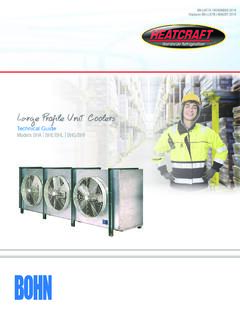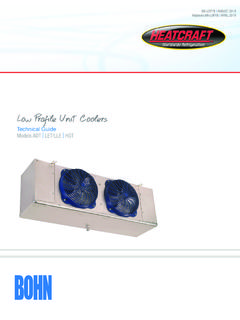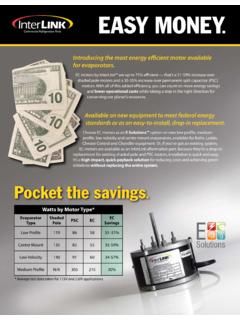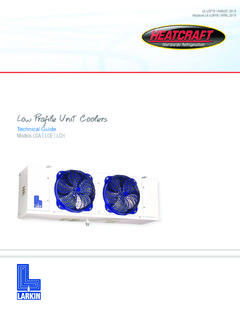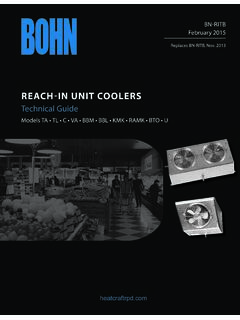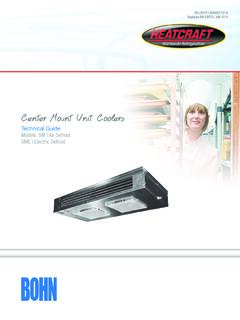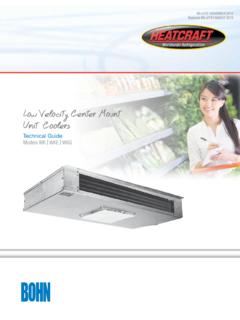Transcription of Why and How we Use Capacity Control
1 Why and How we Use Capacity Control On refrigeration and air conditioning applications where the load may vary over a wide range, due to lighting, occupancy, product loading, ambient weather variations, or other factors, some means of compressor Capacity Control is desirable for optimum system performance. Capacity modulation can reduce power and energy consumption, provide better dehumidification, reduce compressor cycling, decrease the starting load, and provide good oil return if properly piped. The simplest form of Capacity Control is on-off cycling of the compressor. Under light load conditions, this could lead to short cycling and could reduce the life of the compressor. On systems where ice formation is not a problem, users will sometimes lower the low pressure cut out setting beyond the design limits in order to prevent short cycling. As a result, the compressor may operate for long periods at extremely low evaporator temperatures. Compressor Capacity decreases as suction pressure decreases.
2 Refrigerant velocity is inadequate to return oil to the compressor also resulting in a high compressor superheat, which causes the compressor to overheat. All of these conditions can cause pre-mature compressor failure. Capacity Control allows more continuous operation of the compressor, minimizing electrical problems and improving lubrication. There are many ways to achieve Capacity Control . Variable speed compressors, hot gas bypass with or without liquid injection, unloading, Moduload, Digital Control for scrolls, and simple on/off compressor operation on multiple compressor setups. Some applications will use two or more methods for smoother switching and better Control such as unloading in conjunction with hot gas bypass. This article will deal with the most common methods today which are unloading and hot gas bypass. 4, 6, and 8 Cylinder UNLOADING Blocked suction internal unloading has been successfully used for many years to unload 4 and 6 cylinder reed compressors for air-conditioning applications.
3 More recently, blocked suction unloading has been applied on selected 4, 6, and 8 cylinder Discus compressors for high, medium, and low temperature applications. Compressor Capacity modulation can reduce power consumption, provide continuous dehumidification, re- duce compressor cycling and decrease the starting electrical load. Blocked suction Capacity Control also makes efficient compressor operation possible when the compressor is unloaded. Internal Capacity Control Valve Construction A schematic illustration of the internal valve operation is shown in Figure 1. In the normal (full Capacity ) operating position with the solenoid valve de-energized, the needle valve is seated on the lower port, and the unloading plunger chamber is exposed to suction pressure through the suction port. Since the face of the plunger is open to the suction chamber, the gas pressures across the plunger are equalized, and the plunger is held in the open position by the spring. When the solenoid valve is energized, the needle valve is seated on the upper port, and the unloading plunger chamber is exposed to discharge pressure through the discharge pressure port.
4 The differential between discharge and suction pressure forces the plunger down, sealing the suction port in the valve plate, thus preventing the entrance of suction vapor into the unloaded cylinders. The seal on the unloading plunger minimizes any leakage in pressure so that a pump down cycle may be used with the valve either energized or de-energized without excessive compressor cycling. Application When an unloading valve in a operating system is switched from the loaded to the unloaded position, a new system balance takes place. In air-cooled systems the suction pressure will rise and the condensing pressure will drop. In water-cooled systems the suction pressure will rise, but the condensing pressure will remain substantially the same. The pressure or temperature Control should have as wide a differential as necessary to prevent rapid cycling of the unloading valve. Rapid cycling can lead to wear and premature failure of the solenoid valve and/or internal un-loader components.
5 The un-loader cycle rates should be limited to no more than 10 to 12 per hour to ensure satisfactory un-loader life. A wider differential will be required with the pressure Control method than the temperature Control method because of the thermal mass (or flywheel effect) of the cooled medium. Application Requirements Because of the decreased volume of suction vapor returning to the compressor from the system and available for motor cooling, the operating range of unloaded compressors must be restricted. Reed style compressors should be limited to a minimum evaporating temperature of 25 F when operating unloaded. Discus compressors can be operated unloaded below 25 F with the addition of head cooling fans and oil coolers. The Capacity Control valve is in the normal discharge position (loaded) when de-energized, and in the unloaded position when energized. The solenoid valve may be energized either by means of a reverse acting low pressure Control or a temperature Control thermostat.
6 On six cylinder compressors with two un-loaders, two stage thermostats may be employed, but if sequence Control of un-loaders from compressor suction pressure is desired, two separate controls are necessary. Although the leak back rate when the coil is energized during a compressor off cycle is minimal, to prolong the solenoid coil life it is recommended that the Capacity Control solenoid valve be de-energized when the compressor is not operating. In Control circuits operating at line voltage, the solenoid valve and Control can be connected to the load side of the contactor as in Figure 6. The un-loader solenoid valve will then be de-energized and closed when the compressor is not operating. On large installations, the Control circuit may have a power source independent of the compressor power supply. In such cases the unloading solenoid valve and Control may be connected as shown in Figure 6, or they may be connected in parallel with the compressor contactor coil as in Figure 7.
7 Figure 6 Figure 7 Piping One very important factor to be considered in the design of any system equipped with an unloading type compressor is the gas velocity. It must be maintained at a sufficiently high level to insure oil return to the compressor when it is unloaded. When an unloading type compressor is employed on a single evaporator with a single suction line, it may be necessary to employ double risers constructed as shown to insure oil return. If the unloading type compressor is to be installed on a system employing multiple evaporators with solenoid valves to Control the flow of refrigerant to the evaporators, a separate suction line should be run from each evaporator to the machine room and there connected into a common line, which must slope downward toward the compressor. See Figure 8. Expansion valves for systems with unloading compressors must be able to Control the refrigerant flow while the compressor is unloaded as well as when loaded.
8 They generally cannot maintain stable Control below 25-35% of their rated Capacity and, therefore must not be oversized for the fully loaded condition. Figure 8 3 Cylinder Unloading Copeland has developed Modu-load, an efficient method for unloading small Discus compressors. Modu-load will permit efficient unloading on Copeland compressors with less than 4 cylinders for high, medium, and low temperature applications. Moduload assures smooth, vibration free operation in the unloaded mode by unloading all cylinders equally. Theory of Operation Modu-load compressors unload by allowing compressed gas to fill a storage chamber above each cylinder and re-expand back into the cylinder during the suction stroke. As the gas re-expands, both volumetric efficiency and compressor Capacity are reduced. The energy consumed during compression is almost completely recovered during re-expansion, resulting in high efficiency in the unloaded mode.
9 Modu-load uses a piston, cylinder, and spring mechanism which are solenoid actuated. All cylinders are unloaded equally, thus providing well-balanced operation at all times. Since compressed gas is re-expanded to obtain unloading, the percent Capacity reduction is a function of operating compression ratio. The higher the compression ratio, the greater the percent Capacity reduction during unloading. Capacity Control Valve Construction The unloading assembly is considerably different in design from either the blocked suction unloading used on Copeland 4, 6, and 8 cylinder. The unloading hardware consists of a spring and plunger assembly for each cylinder housed in a chamber mounted on top of the valve plate. See Figure 1. In the fully loaded operating mode (with the solenoid valve de-energized), the solenoid needle valve is seated in the upper port, and the top of the unloading piston is exposed to discharge pressure through the discharge pressure port. The high pressure discharge gas on top of the un-loader piston forces it to remain seated in the Discus valve.
10 When unloaded operation is required, the solenoid valve is energized. The needle valve seats in the lower port, and the unloading piston chamber (above the unloading piston) is exposed to suction pressure through the suction port. With suction pressure on top of the piston, the spring force underneath the piston is sufficient to move the piston to the top of the chamber. In this position, the un-loader piston opens a passage in the center of the Discus valve through which high-pressure gas enters the expansion chamber during the compression stroke. During the suction stroke, the gas contained in the unloading chamber re-expands through the passage into the cylinder thus reducing Capacity . Modu-load Performance When operating unloaded, the percent of full load Capacity is a function of operating compression ratio. The higher the ratio, the greater the Capacity reduction. Application Basically the same as the un-loader operation Operating Envelope Low temperature as well as high and medium temperature applications are approved for Modu-load unloading because of reductions in compressor operating temperatures due to Discus valving and improved internal gas flow.

